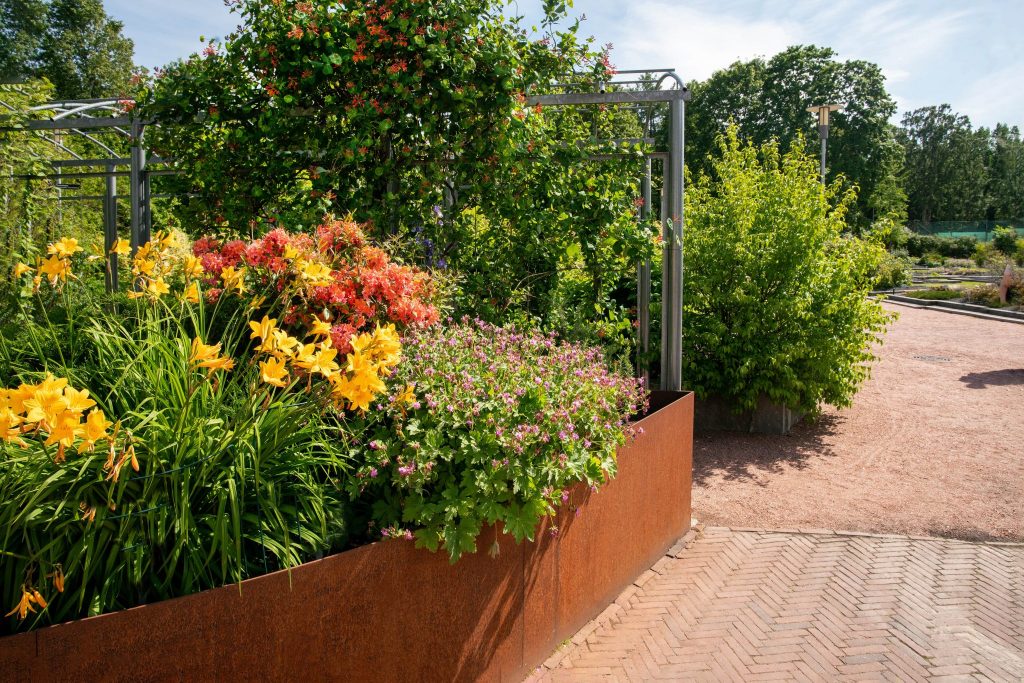Corten vs Mild Steel
What Is The Difference Between Corten And Mild Steel?
No matter whether it is a residential or commercial area when it comes to creating the perfect outdoor space, it is essential to be using the right materials. Steel is a fantastic option for use throughout the property, providing great strength, longevity and aesthetics. However, when it comes to choosing between Corten and Mild Steel, which is the best material for you?

Contents
What is Corten steel?
Corten steel also known as weathering steel is a high-strength, low alloy steel originally developed to eliminate the need for painting. The material is popularly used to create outdoor sculptures including the Angel of the North and large infrastructure such as bridges due to its incredible properties and huge range of benefits. The name COR-TEN refers to the two distinguishing properties of this type of steel: corrosion resistance and tensile strength
Nowadays, it is commonly used in the architectural and landscape industries due to the beautiful finish that develops when exposed to the elements.
Read More: What is Corten Steel? »
What is mild steel?
Mild steel is the most commonly used and widely available low-carbon steel on the market and is typically used in projects where a large quantity is required, such as in structural projects. The material’s high strength, flexibility and low cost make it a very economical solution.
So, what is the difference?
Both mild steel and Corten steel are able to provide a huge array of benefits to users, but there are a few key differences between the two:
Appearance
At first glance, both Corten and mild steel have a dark blue surface, appearing strikingly similar. However, as they are exposed to the elements, the weathering process starts and their aesthetics evolve. Corten steel develops a beautiful orange patina in the early days before darkening to an orange-brown hue, providing a uniquely appealing, rustic finish. Mild steel, on the other hand, tends to develop a darker orange-brown finish right from the start.
The weathering process for Corten steel typically takes around 6-9 months, depending on weather conditions, while for mild steel it generally takes slightly longer. Once fully weathered, the two materials look very similar and can be hard to distinguish without closer inspection.

Corrosion
Although both mild steel and Corten steel do look similar after the complete weathering process, they do have very different corrosion results.
Over time, Corten will develop its unique layer of rust on the surface, which effectively acts as a protective barrier that prevents the steel itself from corroding, this means that Corten has an extremely long life span, degrading at a significantly slower pace compared to mild steel.
Mild steel does not have that same effect, which means when exposed to the elements without a protective coating, it will begin to corrode at a much faster rate and will require replacement sooner.
Composition
A closer look at the composition of these materials reveals further differences. Mild steel is mainly composed of iron and a small amount of carbon. Corten steel, while also made up of iron and carbon, is an alloy steel. The additional alloying elements include chromium, nickel, copper and phosphorous, providing Corten steel with its unique self-protecting properties and giving it an edge in terms of longevity
Cost
Another major difference between Corten and mild steel is their price point. Corten products typically cost around 50% more on average than mild steel products. However, given Corten’s longevity and lower maintenance needs, it represents a long-term investment. Mild steel is certainly a cost-effective alternative, but if a protective coating, such as powder coating or galvanising, is applied for added longevity, the cost comparison with Corten starts to level out.
Sustainability
In today’s environmentally conscious world, it’s essential to consider the sustainability factor. Both Corten and mild steel are 100% recyclable, aiding in reducing environmental footprint. Arguably, Corten Steel takes the lead in environmental friendliness. Its unique property of forming a protective layer eliminates the need for paint or a protective coating which can be harmful to the environment.
Are you looking to add steel products to your outdoor space?
Wrapping up, both Corten and mild steel have their distinct advantages. Corten steel, with its superior corrosion resistance, unique weathering aesthetics, and environmental benefits, is an excellent long-term investment. On the other hand, mild steel provides a cost-effective solution with extensive versatility and the option to enhance its durability through the addition of protective coatings if needed.
If you are looking to discover the many benefits that come from adding steel products to your garden, Lux Unique is here to help you. From planters and edging to log stores and water features, all of our products are designed and manufactured right here in the UK and are the perfect way to enhance your outdoor space. So if you want to find out more, browse our wide range of products today or contact our team at hello@luxunique.co.uk who will be happy to help.
